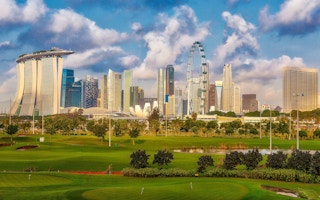What should a “green” city look like? Should it resemble Copenhagen, with its high rates of bicycle commuting and recycling? What about Curitiba, the capital of Brazil’s Paraná state, with its pedestrian-centered planning? Or perhaps Ethiopia’s capital, Addis Ababa, which is powered entirely by renewable energy?
With more than 50 per cent of the world’s population now living in urban areas—a share that is rising fast—the answer to this question will shape our collective future. But it may be more straightforward than we realise: to make cities “greener”—that is, less polluted, more resource-efficient, and more environmentally resilient—we should make them literally greener.
Discussions about “greening” cities typically recognise the importance of sustainable infrastructure and smart urban planning. What they often overlook is that nature is the world’s original infrastructure, and nature-based solutions can help cities address some of the biggest planning challenges they face, such as air and water pollution, water scarcity, and extreme heat, all of which are now being exacerbated by climate change.
“
We cannot solve the problems created by concrete and turbines with more concrete and turbines.
In some cases, nature-based solutions are at least as cost-effective as conventional built infrastructure, not least because they can often address multiple challenges at once. And, as planting trees along streets demonstrate, such solutions do not have to be complicated.
Street trees, research shows, can help reduce air pollution—the single biggest threat to human health, especially in urban areas, according to the World Health Organization—by filtering fine particulate matter, such as that emitted by internal-combustion engines. They are also highly effective at combating the “urban heat island effect,” which can result in dangerously high summer temperatures.
Of course, the benefits of planting trees are highly localised. But that makes them particularly effective as a targeted intervention—say, as a screen against a busy road or industrial area, or to protect vulnerable areas like schools and nursing homes.
Moreover, planting trees in lower-income, under-resourced neighborhoods, which often have less canopy cover, can help to mitigate environmental inequality. That is why my organisation, The Nature Conservancy, is working with other nonprofits, community organisers, and public-health researchers in Louisville, Kentucky, to plant more trees in areas with low canopy cover, and to conduct the first controlled trial of trees as a medical intervention.
Another major urban challenge that nature can help address is water management. The materials that compose modern cities are mostly impermeable, so they cannot absorb rainwater. As a result, during heavy storms, the runoff overloads drainage systems, causing pollutants to run through city streets and into local ecosystems.
Rain gardens—small pockets of native vegetation planted in natural depressions and low points—can resolve this problem by collecting and filtering rainwater, so that it can be reabsorbed by the Earth, resulting in recharged aquifers and increased biodiversity.
In Chinese “sponge cities” such as Shenzhen, rain gardens, together with green roofs and artificial wetlands, are already being used to manage storm water, aided by permeable paving materials that allow water to filter through to the substrate.
Natural interventions beyond a city’s borders can also help to address water-management challenges. In Nairobi, increased agricultural activity in the Upper Tana watershed resulted in such heavy sediment runoff that it reduced water flows downstream to the city. The resulting water shortages disproportionately hurt the poorest residents, who were often forced to buy jerrycans of water at exorbitant prices. Hydropower production also fell.
Now, Nairobi is working with its rural neighbors to use nature-based solutions to address water-security issues at the source. Through the Nairobi-Upper-Tana Water Fund, the combined resources of government and business are helping farmers implement more sustainable agricultural practices, such as the use of cover crops, resulting not only in increased water flows to Nairobi, but also in higher agricultural yields.
Other water funds that The Nature Conservancy has helped to develop around the world have proved to be similarly beneficial. This is important, because nearly half of all cities around the world experience periodic water scarcity, with those that rely on surface water especially vulnerable.
Nature-based solutions may not be sufficient to solve all of the challenges facing a particular city. Urban areas may also need well-designed, sustainably built infrastructure to manage air and water, and integrated clean-energy systems and efficient public-transit options to help reduce pollution and carbon emissions.
But nature-based solutions—if sufficiently funded and implemented in an equitable manner—offer benefits that we can no longer afford to ignore. The technology and infrastructure that have allowed cities to flourish in the past carried high costs, from pollution to flooding to biodiversity loss. As climate change reshapes our planet, these threats are growing and shifting, compounding the challenge further.
We cannot solve the problems created by concrete and turbines with more concrete and turbines. We need flexible solutions that can make our cities more resilient, sustainable, and adaptable, without undermining the urban dynamism and prosperity on which we rely. Nature itself can offer such solutions and be a catalyst for healthier, more vibrant neighborhoods, driving investment and making cities more successful by any measure.
Pascal Mittermaier is global managing director for Cities at The Nature Conservancy.
Copyright: Project Syndicate, 2018.











